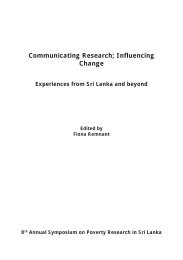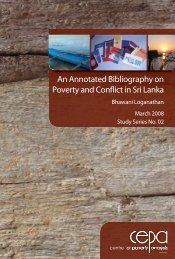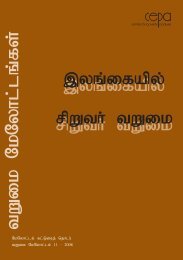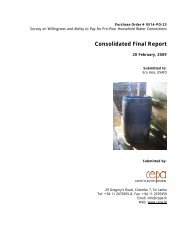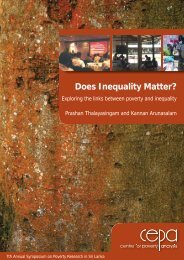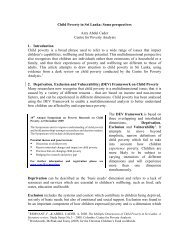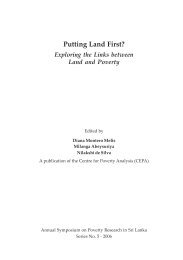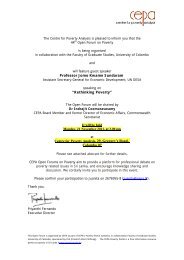Involuntary Displacement and Resettlement â Policy and ... - CEPA
Involuntary Displacement and Resettlement â Policy and ... - CEPA
Involuntary Displacement and Resettlement â Policy and ... - CEPA
- No tags were found...
Create successful ePaper yourself
Turn your PDF publications into a flip-book with our unique Google optimized e-Paper software.
Phase IV – Consolidation, Community Integration <strong>and</strong> Income Restoration:Livelihood restoration programmes were put into action <strong>and</strong> NeighbourhoodForums were established. These encompassed a mixture of low, middle <strong>and</strong>higher income residential groups in a geographically defined area, sometimesextending beyond the boundaries of the directly affected settlements.7 Key Achievements <strong>and</strong> Current StatusKey Achievements: Revising the project to include the NIRP guidelines <strong>and</strong>refining the organizational structure in keeping with these changes <strong>and</strong>obtaining Rs. 600 million from the government to fund the revised budget. Astaff training <strong>and</strong> capacity building programme was developed <strong>and</strong>implemented. The services of a leading NGO were obtained to assist <strong>and</strong>facilitate PAPs in the resettlement process <strong>and</strong> act as an intermediary.Acquisition of l<strong>and</strong>, preparation of resettlement sites, lay out plans <strong>and</strong> housedesigns were all developed with the full participation of PAPs, who were giventhe choice of on-site or off-site resettlement. Tailor made income restorationprogrammes were developed <strong>and</strong> the project established links between banks,private sector partnership programmes <strong>and</strong> the PAPs.As a result of this innovative resettlement programme, 100% of householdsliving on unauthorised l<strong>and</strong> <strong>and</strong> on government permits have now agreed toresettle voluntarily accepting the entitlement package offered, <strong>and</strong> 90% ofhouseholds with legal ownership of the l<strong>and</strong> <strong>and</strong> houses, most of them ofmiddle <strong>and</strong> higher income levels, have agreed to resettle voluntarily. Only 15out of 1882 PAPs, less than 1% of the total, have taken legal action againstthe project. These cases are now being negotiated.Current Status: The total number of households directly affected due to thefrequent flooding in the Lunawa catchment is about 18,000. The problem iscompounded by the contamination of water by untreated toxic wastedischarged into waterways by industries in the area. People in the catchmentare both physically <strong>and</strong> hygienically affected due to flooding. Theenumeration survey undertaken in mid 2002 estimated that 567 householdshad to be resettled for drainage system improvement. However, thesubsequent assessment carried out on the basis of the revised scope of theproject found that the total number of households affected was 855.156



